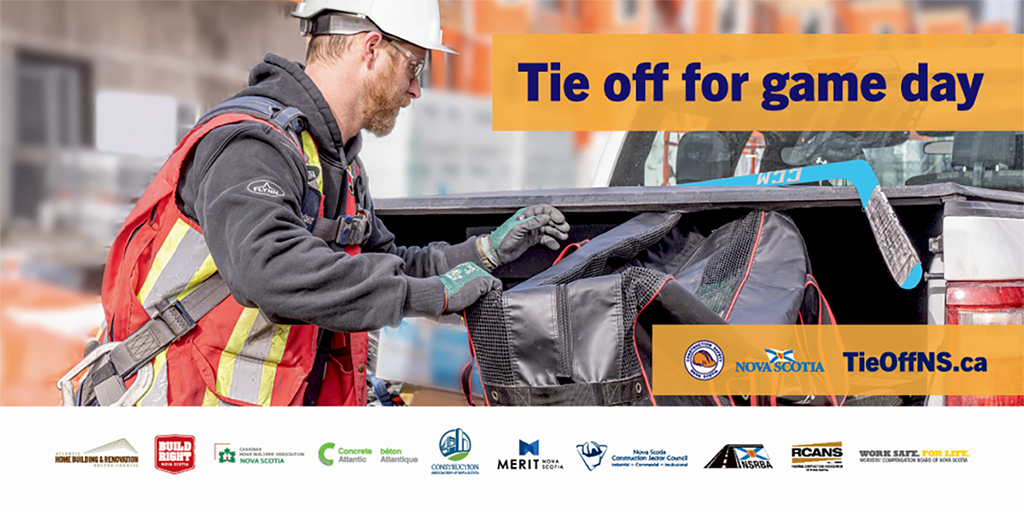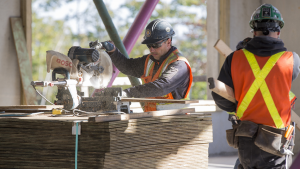A worker who isn’t tied-off trips and falls from the roof of a building.
A labourer slips on a ladder and topples to the ground.
It happens on a regular basis in Nova Scotia.
Every year in the province, construction workers die on the job or are severely injured as a result of improper fall protection when working at heights.
Time-loss claims in construction that involved falls increased by nearly 50 per cent from 2021 to 2022. Last year, there were 15,259 days lost to workplace injury from falls in the sector.
To combat the problem, Construction Safety Nova Scotia (CSNS) has joined forces with 13 other organizations across the province, including the provincial government’s occupational health and safety division, to launch a new fall awareness campaign to make employers and workers think about the danger.
The group, called the Construction Safety Coalition, which involves members from labour organizations, non-labour groups and government, has launched the campaign across multiple channels and mediums. A new website called TieOffNS has been rolled out which has resources and information about fall protection legislation and separate sections targeted to both employers and workers.
Messages are also being splashed across billboards and buses, and the campaign is being featured on radio, TV, social media and more. The department of labour kicked in a $150,000 grant for the crusade.
MJ MacDonald, CEO of CSNS, says the organizations as well as government officials were concerned about an uptick in falls and felt action was needed.
“I am tired of driving by sites and seeing workers with their safety harnesses on but not tied-off,” she says. “There’s just no excuse. A harness can save your life but not unless it’s tied-off. I am hopeful that this campaign will remind everyone working at height on construction sites that this behaviour is not OK.”
In 2021, there were 100 time-loss claims in construction due to falls. That number increased to 149 in 2022. The most common injury types from falls in construction are sprains/strains and fractures/dislocations.
According to MacDonald, slips and trips are the major causes of falls. Workers can slip on a surface or fall through an open area that is not guarded on a construction site. Injuries can also occur when a ladder or scaffolding fails or if a worker doesn’t properly tie-off or has gear that isn’t in good condition.
“Sometimes there’s harnesses out there that might not be in the best of conditions,” says MacDonald. “If you have a failure of your fall arrest system, it won’t do any good.”
The coalition launched the campaign to get the message across that workers should tie-off because of their families and loved ones.
“We worked with our sister organizations and stakeholders in the province to design and now implement a campaign around this and raise awareness that it’s not OK to be up there without a harness,” says MacDonald.
There is also a good business case to be made for fall awareness training as there is a huge return for taking proper safety precautions.
CSNS looked at injury data, WCB premiums and funds invested in the organization in the province for the last 28 years. The organization found $33 million was invested in CSNS during that period but had injuries remained on the same trajectory over the years, WCB premiums would have been more than $300 million.
“Having trained talent that is able to work productively and be healthy and injury-free is really important,” says MacDonald.
Productivity increases because companies don’t have to hire and train new employees to backfill when somebody is injured.
In addition, employers pay less in WCB premiums when time-loss injuries are lower.
In Nova Scotia, fall protection systems are required when working at a fall distance of three metres or more above the nearest safe surface or water, when working at less than three metres above any surface or thing that could cause injury during a fall, or when working above exposed hazardous material, such as in an open tank, bin, pit or vat.
Working above exposed rebar, for example, could result in impalement and serious injury even if the fall is less than three metres.
There are many different types of fall protection systems, including guardrails, temporary flooring, personnel safety nets, travel restraint systems and fall-arrest systems.
Fall protection systems may include the use of equipment and components such as body-belts, energy absorbers, full-body harnesses, lanyards, lifelines (horizontal or vertical), self-retracting devices and work-positioning systems.
In Nova Scotia, employers are responsible for ensuring a safe worksite and making sure that proper fall protection systems are in place and procedures followed. Workers are responsible for ensuring they are tied-off and using fall protection properly.
MacDonald says the campaign has been welcomed by the industry.
“What we’re hearing from our stakeholder groups and our board and people that we interact with a little more, is that there is really strong support for it. Through social media, there’s been a lot of positive feedback.”
The campaign runs until October.






Recent Comments